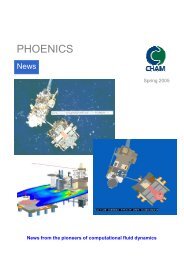PHOENICS Virtual Wind Tunnel - Aertia
PHOENICS Virtual Wind Tunnel - Aertia
PHOENICS Virtual Wind Tunnel - Aertia
Create successful ePaper yourself
Turn your PDF publications into a flip-book with our unique Google optimized e-Paper software.
<strong>PHOENICS</strong> VWT<br />
<strong>PHOENICS</strong> VWT (<strong>Virtual</strong> <strong>Wind</strong> <strong>Tunnel</strong> ) is a software<br />
package aimed at motorsport applications. The VWT<br />
uses mathematical techniques of computational fluid<br />
dynamics (CFD) to simulate any process involving<br />
fluid flow (in this case air). CFD packages have been<br />
available for many years but have, traditionally, been<br />
the preserve of big-budget teams due to the computing<br />
power required, the cost of the software, and the skills<br />
necessary to use it.<br />
One of the main aims of the VWT is to simplify the<br />
initial set up of a case to provide realistic results. The<br />
VWT‘s VR-Editor is an interactive environment to load<br />
a particular design and set the parameters to be used<br />
for the computation. Results can be visualized within<br />
the VWT’s VR-Viewer after the case is run. The display<br />
tools available include vectors, contours, iso-surfaces,<br />
and streamlines for both velocity and pressure. The<br />
forces on the vehicle body are also calculated to produce<br />
information on lift and drag.<br />
SETTING UP VWT<br />
Domain Size<br />
The cross sectional area of the domain (the volume<br />
within the red lines) can be adjusted to ensure that the<br />
walls of the domain do not have an undue influence on<br />
the geometry under test. It is accepted practice that the<br />
geometry under test should be no more than 5% to 7.5%<br />
of the total cross-sectional area.<br />
Streamlines over front wheel.<br />
The increasing affordability of powerful desk-top<br />
computers removes one barrier and development of<br />
the available software allows engineers who are not<br />
CFD specialists to make use of the tool. Carrying out<br />
aerodynamic simulations that provide lift and drag<br />
information to influence decisions on design before<br />
physical testing is, therefore, a practical option.<br />
Test Velocity.<br />
The test velocity is set for both the inlet and the road.<br />
Setting a velocity for the road ensures that ground effects<br />
can be analysed and provides a similar function to that<br />
of a moving road or driven belt that would be found in a<br />
wind tunnel.<br />
It is often not possible to validate specific designs in a<br />
wind tunnel, either due to cost or time constraints. In<br />
this case <strong>PHOENICS</strong> has been demonstrated to provide<br />
results that agree closely with physical tests across a<br />
wide range of applications providing that the geometry<br />
of the electronic model is accurate and that care is taken<br />
when setting the grid and system parameters.<br />
Domain Set Up<br />
22








